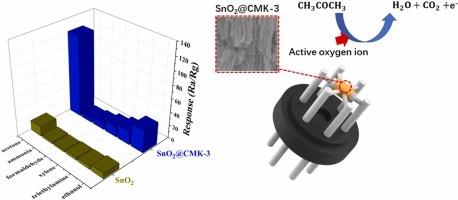锚定在有序介孔碳上的氧化锡纳米粒子用于高效丙酮传感
IF 8
1区 化学
Q1 CHEMISTRY, ANALYTICAL
引用次数: 0
摘要
合理设计半导体金属氧化物(SMO)与碳材料的组合可开发出具有优异气体性能的传感材料。本文采用溶热法和高温煅烧法合成了装饰在有序介孔碳(CMK-3)纳米棒上的二氧化硒纳米颗粒(NPs)。各种表征和气体传感测试表明,所得到的一维(1D)自组装 SnO2@CMK-3 复合材料具有较大的比表面积(88.02 m2/g)和优异的气体传感性能。具体而言,在最佳工作温度下,所制备的 SnO2@CMK-3 传感器对 50 ppm 丙酮具有高响应(122.1)、低检测限、良好的线性拟合(R2=0.9892)、快速响应/恢复时间(5/27 s)。同时,通过检测丙酮、氨气、甲醛、二甲苯、三乙胺和乙醇等六种气体,发现 SnO2@CMK-3 传感器对丙酮具有良好的选择性。独特的纳米结构、较大的比表面积、较高的氧空位含量以及异质结的形成是其对丙酮具有良好性能的原因。这些结果突显了 SnO2@CMK-3 复合材料在检测丙酮气体方面的潜在应用,并为制备 SMO@carbon 复合材料检测挥发性有机化合物提供了一种前景广阔的方法。本文章由计算机程序翻译,如有差异,请以英文原文为准。

Tin oxide nanoparticles anchored on ordered mesoporous carbon for efficient acetone sensing
Rationally designed combinations of semiconductor metal oxides (SMO) and carbon materials can lead to the development of sensing materials with excellent gas performance. Herein, SnO2 nanoparticles (NPs) decorated on ordered mesoporous carbon (CMK-3) nanorods were synthetized by solvothermal and high-temperature calcination methods. Various characterization and gas sensing tests indicated that the resulting one-dimensional (1D) self-assembled SnO2@CMK-3 composite had a large specific surface area (88.02 m2/g) and excellent gas sensing performance. Specifically, at optimal working temperature, the as-prepared SnO2@CMK-3 sensor had a high response (122.1), low limit of detection, good linear fitting (R2 = 0.9892), rapid response/recovery time (5/27 s) towards 50 ppm acetone. Meanwhile, by detecting six gases, including acetone, ammonia, formaldehyde, xylene, triethylamine, and ethanol, it was found that the SnO2@CMK-3 sensor showed good selectivity to acetone. The unique nanostructure, large specific surface area, high oxygen vacancy content, and the formation of heterojunctions accounted for the good performance to acetone. These results highlighted the potential application of the SnO2@CMK-3 composite for the detection of acetone gas and presented a promising approach to prepare SMO@carbon composites for VOCs detection.
求助全文
通过发布文献求助,成功后即可免费获取论文全文。
去求助
来源期刊

Sensors and Actuators B: Chemical
工程技术-电化学
CiteScore
14.60
自引率
11.90%
发文量
1776
审稿时长
3.2 months
期刊介绍:
Sensors & Actuators, B: Chemical is an international journal focused on the research and development of chemical transducers. It covers chemical sensors and biosensors, chemical actuators, and analytical microsystems. The journal is interdisciplinary, aiming to publish original works showcasing substantial advancements beyond the current state of the art in these fields, with practical applicability to solving meaningful analytical problems. Review articles are accepted by invitation from an Editor of the journal.
 求助内容:
求助内容: 应助结果提醒方式:
应助结果提醒方式:


